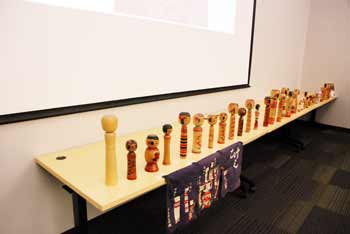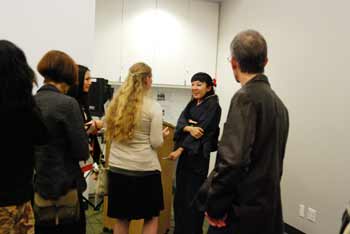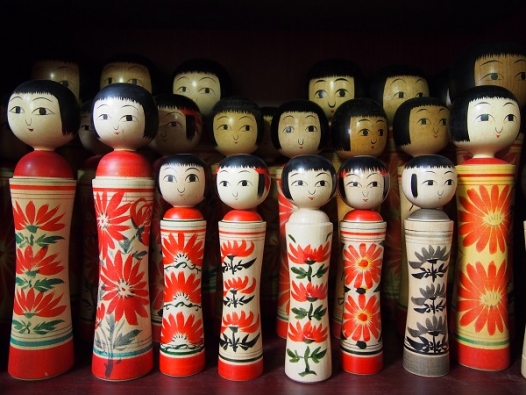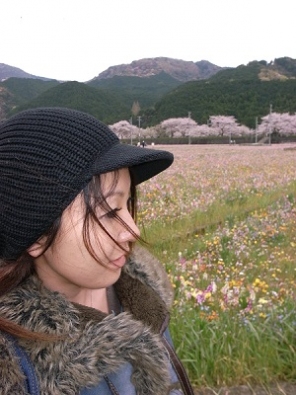

By Alex Forbess
 Several dolls were lined up formidably in front of the lecture room as spectators entered to be amazed of their simple features. From their shy faces to their colorful stripes and unique designs, everyone wondered how these armless dolls, the Kokeshi, couldbe portrayed as a powerful symbol of the Tohoku region. Featured journalist and author Manami Okazaki, who wore a dark, denim kimono with pink stitching and black converse shoes, not only explained how the Kokeshi nurtured victims of 3.11 but also how they were the pioneers of Japan's well-known Kawaii culture. During her recent trip to Tohoku in 2012, Okazaki was originally researching Japan's obsession of all that is cute. Her further interest in Kokeshi came after interviewing a source who said, "If you want to know Kawaii, look at the Kokeshi."
Several dolls were lined up formidably in front of the lecture room as spectators entered to be amazed of their simple features. From their shy faces to their colorful stripes and unique designs, everyone wondered how these armless dolls, the Kokeshi, couldbe portrayed as a powerful symbol of the Tohoku region. Featured journalist and author Manami Okazaki, who wore a dark, denim kimono with pink stitching and black converse shoes, not only explained how the Kokeshi nurtured victims of 3.11 but also how they were the pioneers of Japan's well-known Kawaii culture. During her recent trip to Tohoku in 2012, Okazaki was originally researching Japan's obsession of all that is cute. Her further interest in Kokeshi came after interviewing a source who said, "If you want to know Kawaii, look at the Kokeshi."
Kokeshi, a name made up with no intentional meaning, was first recorded sometime between 1880 and 1850 being sprung near the onsens(hot springs) of Tohoku, yet some evidence claims they may have started even years before. From a first impression, the production process looks simple: one master and one apprentice; but Okazaki explained how each step, such as having the wood spin and create friction to mold the body, are essential and the learning steps are equally rigorous. She said that compared to making a kimono, where each section is neatly divided by the designers and tailors with items presented, everything starts from square one to make a Kokeshi. "First, everything is made from scratch. Even the tools," Okazaki explains, "They (the master and the apprentice) do everything themselves. To perfect this art, the apprentice would live in the artisan's house a follow a strict system. From molding the perfect wood to gently painting stripes with a brush, Okazaki said it usually takes the apprentice about ten years to perfect this art; however, even doing this for 50 years, seasoned-artisans admit they are still learning to improve. "Artisans believed in two things while making the Kokeshi," Okazaki said, "There's the technical aspect, knowing how to perfect it, and the psychological aspect. It's having the right attitude to make something. They believe if you don't have the soul while you make it, you're a fake."
 At first, the Kokeshi were meant to be children's toys but then adults started to grow fond of their design. Each of the eleven Kokeshi at the lecture room had its own personality. From the common Naruko, which gives a faint "squeak" whenever a handler turns its head, to the Hijiori's large, rectangular head and slender body, more people have felt compelled to have one. While they have unique features, there is one similarity: the face. It is its shy, simple face that attracted people. Okazaki said it was not something that appealed to people first but within time, they cherished them. "What you don't fall in love with instantly is what they liked the most," Okazaki said.
At first, the Kokeshi were meant to be children's toys but then adults started to grow fond of their design. Each of the eleven Kokeshi at the lecture room had its own personality. From the common Naruko, which gives a faint "squeak" whenever a handler turns its head, to the Hijiori's large, rectangular head and slender body, more people have felt compelled to have one. While they have unique features, there is one similarity: the face. It is its shy, simple face that attracted people. Okazaki said it was not something that appealed to people first but within time, they cherished them. "What you don't fall in love with instantly is what they liked the most," Okazaki said.
Its popularity, Okazaki further explains, really expanded around 1965 where tourists flourished to the Tohoku onsens. Eventually there were phonebooks filled with Kokeshi artisans for people to order a specific design. With the influence of the housing bubble, some customers even demanded to purchase Kokeshi that were "as big as their house." And within one to three months, theKokeshi would arrive without warning.
While their popularity increased, Okazaki told everyone the artisans' are finding it hard to find more young people to become apprentices and continue with this traditional doll; however, more modern Kokeshi are being developed to attract younger audiences one way or another, such as Hello Kitty Kokeshi. Okazaki said that some artisans believe young people do not have the patience to learn the process. Regardless, the Kokeshi has attracted people abroad and adore these creations made from a remote, thriving section of Japan. Kokeshi: a name that means nothing, yet somehow, everyone started to put their own meaning into them, making them charitable and heartwarming for everyone to share.
Thursday, April 17th, 7:00PM

Venue:
The Japan Foundation, Los Angeles
(5700 Wilshire Blvd. # 100, Los Angeles, CA 90036)
Manami Okazaki
 Manami Okazaki is a journalist and author originally from Australia, now based in Japan. Among her best selling titles are the recent books "Kawaii, Japan's Culture of Cute,"(Prestel) "Kokeshi, from Tohoku with Love,"(Kingyo) "Kicks Japan" (Mark Batty) and"Wabori, Traditional Japanese Tattoo" (Kingyo). Her books have been featured in newspapers and magazines such as the Independent, the Japan Times, WSJ, WSJ Live, MTV, LA Times, O Globo, Vogue, Mac Design Directoryamongst others.
Manami Okazaki is a journalist and author originally from Australia, now based in Japan. Among her best selling titles are the recent books "Kawaii, Japan's Culture of Cute,"(Prestel) "Kokeshi, from Tohoku with Love,"(Kingyo) "Kicks Japan" (Mark Batty) and"Wabori, Traditional Japanese Tattoo" (Kingyo). Her books have been featured in newspapers and magazines such as the Independent, the Japan Times, WSJ, WSJ Live, MTV, LA Times, O Globo, Vogue, Mac Design Directoryamongst others.
She has also contributed to over 50 publications worldwide including the Wall Street Journal's Scene Asia, the Japan Times and transit magazine, and has given talks at the Foreign Correspondents Club Tokyo, and the Japan Expo in Paris (2011, 2013).
In 2012 and 2013, Manami travelled extensively around Tohoku researching Kokeshi, a region she feels a strong affinity with, as her grandparents were from the coastal town of Onagawa -- one of the worst hit areas by the tsunami. In 2013, she published the charity book "Kokeshi, from Tohoku with Love".